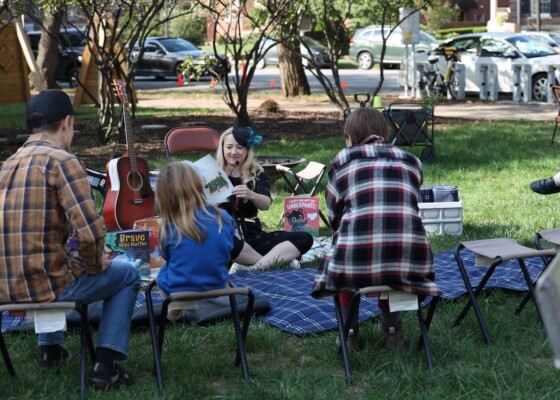The Indiana Dunes: Ways, Paths and Trails
October 25, 2016The first thing that struck me about the dunes were not the dunes themselves: it was the sign in the bathroom warning visitors to stay on the marked trails. If…
The first thing that struck me about the dunes were not the dunes themselves: it was the sign in the bathroom warning visitors to stay on the marked trails. If hikers strayed from those trails, they risked damaging the fragile root systems that are a dune’s only real defense against the eroding violence of wind and rain.
It struck me because I’d chosen readings based on the theme of ways vs. trails. I asked our group to think about the variety of words English has passages we use move from point to point: way, path, trail, road. There are more, of course, and these words exist on a continuum: from hardly defined to precisely marked.
We say, for example, that “love will find a way.” So ways, it seems, emerge from the brush of existence—and perhaps disappear as quickly. We might look back on the way we have taken only to discover that it has dissolved, no trace. A road, by contrast, leaves its mark on the landscape. If you have ever driven along the Appalachian spine or through the Rockies, you know that roads literally cut into and through rock. In between roads and ways, we have words that describe varying levels of definition: a path is a way that enough folks have walked to have some definition; a trail, like a road, might be marked into the landscape in ways that are semi-permanent (wood railings, signs) and, like roads, trails might appear on maps.
In a sense, then, these ways, paths, trails, roads are defined by what they are not. Gary Snyder tells us that “A path is something that can be followed, it takes you somewhere. ‘Linear.’ What would a path stand against? ‘No path.’ Off the path, off the trail. So what’s off the path? In a sense everything else is off the path. The relentless complexity of the world is off to the side of the trail.”
I had chosen this theme because I’d gotten to thinking about the formation of dunes. How is a dune formed? What path is there from nothing to a sudden, towering mound of sand?? Robert Haas tells us in his poem “Variations on a Passage in Edward Abbey”:
A dune begins with an obstacle—a stone, a shrub, a log,
anything heavy enough to resist being moved by wind.
This obstacle forms a wind shadow on its leeward side,
making eddies in the currents, now fast, now slow, of the air,
exactly as a rock in a stream causes an eddy in the water.
Within the eddy the wind moves with less force and less velocity
than the airstreams on either side, creating what geologists call
the surface of discontinuity. And it is here that the wind
tends to drop part of its load of sand. The sand particles,
which hop or bounce along the earth before the wind,
begin to accumulate,
creating a greater eddy in the air currents
and capturing still more sand.
It’s thus a dune is formed.
Note how it begins: obstacles. Roads cut through obstacles. Trails avoid them. Paths and ways wind around them. In other words, these different terms can describe one’s response to obstacles. But in our wake, like the wind, perhaps we leave formations behind us, like dunes. Loose formations, to be sure, fragile. Susceptible to time and the elements, life nonetheless piles up around us. And it is here we might turn to Carl Sandburg’s poem “Dunes,” which we also read on our hike:
WHAT do we see here in the sand dunes of the white
moon alone with our thoughts, Bill,
Alone with our dreams, Bill, soft as the women tying
scarves around their heads dancing,
Alone with a picture and a picture coming one after the
other of all the dead,
The dead more than all these grains of sand one by one
piled here in the moon,
Piled against the sky-line taking shapes like the hand of
the wind wanted,
What do we see here, Bill, outside of what the wise men
beat their heads on,
Outside of what the poets cry for and the soldiers drive
on headlong and leave their skulls in the sun for–
what, Bill?
The poem is one relentless question: “What do we see?” When we reflect on dreams of future and the dead things in the past, when we consider where we have come from and where we are going, what do we see? Is it inexorable and defined like a road? Or is it more like the wind that forms the dune, which responds in the moment as obstacles emerge?
Maybe Sandburg is saying that the Indiana Dunes ask us to sit, “alone with our thoughts, Bill, / alone with our dreams,” to sit here in the present, trying to find our way between these two poles of past and future.
So there I was, staring at the sign: the irony of it struck me. Because I had come prepared to lead our group in a discussion about the potential destructiveness of favoring roads and harshly defined ways that cut into the landscape, that can destroy environments. And yet, here I was looking at a sign that told me to stick to the defined trails in order to protect the dune environment.
We humans are a bit self-centered, and we can’t help but think of ourselves when we are about in nature. Nature is selfless in its reckless abundance: it gives you space to consider your own self. This is why I am thankful for it. And also why I know that I must do what I can to become mindful of how I impact it.
It was a gentle rebuke. I had been ready to encourage everyone to be open paths that emerge, to wander over the dunes (not literally, though we did get to do a bit of wandering at the final stop on the beach). But the sign about the fragility of the dunes reminded me that paths are not always superior to trails–or even roads sometimes. The advice to “follow your inner light” isn’t always best. We are responsible to ourselves, but to the world around us as well.
The responsible life demands a mixture of ways and roads, and all the forms of passage in between. Sometimes literature awakens us to that responsibility. And sometimes so does a sign in the bathroom.
Like the narratives that help us define our selves, which are also fragile. Admittedly, these narratives are imposed to some extent. They cut into the landscape and cause us to neglect things now and then. But they are also a bit like a park ranger who acts reminds us not to slip into reckless disregard. Poems, writing, art, insofar as they contain narratives about our past allow us to give structure and meaning to that past, and they can act like defined trails that help us determine ourselves when necessary.
I had been prepared to tell everyone, these works tell us to be open to the world as it emerges, not to impose ourselves on it. But this was too easy, too imposed—ironically.
—————————————————-
Next Indiana Campfires is a unique way to connect nature, literature and Indiana’s Bicentennial. The program is supported by the Efroymson Family Fund, the Nina Mason Pulliam Charitable Trust and Pulitzer Prizes Centennial Campfires. Indiana Humanities is supported in part by Lilly Endowment Inc. and the National Endowment of the Humanities.
This post is part of the weekly blog series devoted to the initiative. Check back every Tuesday to learn more about Indiana’s great environmental literature, find out interesting facts about Hoosier stewardship, get all the latest program details and more.


